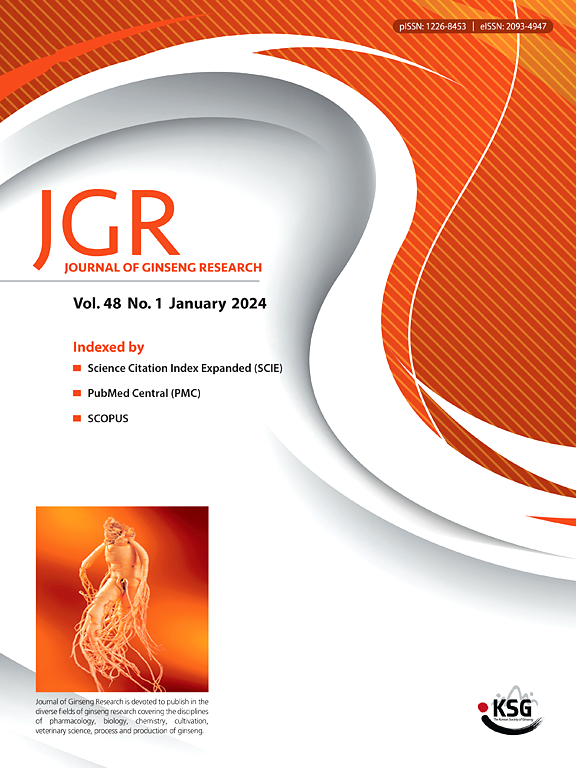人参鲜提液在亚临界水中不同温度下的成分变化及生理活性。
IF 6.8
2区 医学
Q1 CHEMISTRY, MEDICINAL
引用次数: 0
摘要
背景:亚临界水(SW)被认为是一种有效的木质纤维素生物质转化技术。SW对人参的影响仅限于对红参人参皂苷成分的评价,对于SW对鲜参的影响研究甚少。方法:从白度、还原糖和残留固形物含量等方面评价人参提取物的一般特性,并采用色谱法对人参提取物的成分进行鉴定。为了利用转基因作为生物活性食品,测定了其人参皂苷组成、抗氧化活性、血管紧张素转换酶(ACE)抑制活性、益生元潜力和风味特性。结果:随着SW温度的升高,人参的残固含量降低,且在250℃下SW可获得GE的可溶性化合物。尽管人参皂苷含量随SW温度的升高而降低,但Rg5在200℃时急剧升高。在200 ~ 250℃的SW中,GE的抗氧化活性和ACE抑制活性最高。然而,在高于250°C时制备的GE完全失去了益生元潜力。以电子舌为基础,在200°C时,SW对鲜味有增强作用,而在250 ~ 300°C时,SW对甜味和苦味有增强作用。结论:SW具有将人参根产生的木质纤维素废物转化为具有生物活性的食物资源的潜在应用价值,并且SW在~ 200°C下可以潜在地用于增强GE的生理活性。本文章由计算机程序翻译,如有差异,请以英文原文为准。

Compositional changes and physiological activities of fresh ginseng extracts prepared at various temperatures in subcritical water
Background
Subcritical water (SW) is regarded as an effective conversion technology for lignocellulosic biomass. The effect of SW on ginseng are limited to evaluate the ginsenoside composition of red ginseng, and there is little information on the effects of SW on fresh ginseng.
Methods
The general characteristics of ginseng extracts (GE) prepared with SW were evaluated in terms of brix, reducing sugar and residual solid content, and compositions of GE was estimated using chromatography. For utilization of GE as a bioactive food, the ginsenoside composition, antioxidative activity, angiotensin-converting enzyme (ACE) inhibitory activity, prebiotic potential and taste attributes were measured.
Results
Increasing SW temperature decreased residual solid content of ginseng and the soluble compounds of GE were yielded by SW at 250 °C. Despite that ginsenoside content decreased with SW temperature, a steep increase in Rg5 was observed at 200 °C. The SW at 200–250 °C manifested the highest antioxidant activities and ACE inhibitory activity of GE. However, the GE prepared at greater than 250 °C completely lost prebiotic potentials. Based on electronic-tongue, umami taste was enhanced by SW at 200 °C, but sweetness and bitterness were dominated at 250–300 °C.
Conclusion
The results demonstrated that SW has a potential application to convert lignocellulosic wastes generated from ginseng roots into bioactive food resource, and SW at ∼200 °C can be potentially used to enhance the physiological activities of GE.
求助全文
通过发布文献求助,成功后即可免费获取论文全文。
去求助
来源期刊

Journal of Ginseng Research
CHEMISTRY, MEDICINAL-INTEGRATIVE & COMPLEMENTARY MEDICINE
CiteScore
11.40
自引率
9.50%
发文量
111
审稿时长
6-12 weeks
期刊介绍:
Journal of Ginseng Research (JGR) is an official, open access journal of the Korean Society of Ginseng and is the only international journal publishing scholarly reports on ginseng research in the world. The journal is a bimonthly peer-reviewed publication featuring high-quality studies related to basic, pre-clinical, and clinical researches on ginseng to reflect recent progresses in ginseng research.
JGR publishes papers, either experimental or theoretical, that advance our understanding of ginseng science, including plant sciences, biology, chemistry, pharmacology, toxicology, pharmacokinetics, veterinary medicine, biochemistry, manufacture, and clinical study of ginseng since 1976. It also includes the new paradigm of integrative research, covering alternative medicinal approaches. Article types considered for publication include review articles, original research articles, and brief reports.
JGR helps researchers to understand mechanisms for traditional efficacy of ginseng and to put their clinical evidence together. It provides balanced information on basic science and clinical applications to researchers, manufacturers, practitioners, teachers, scholars, and medical doctors.
 求助内容:
求助内容: 应助结果提醒方式:
应助结果提醒方式:


